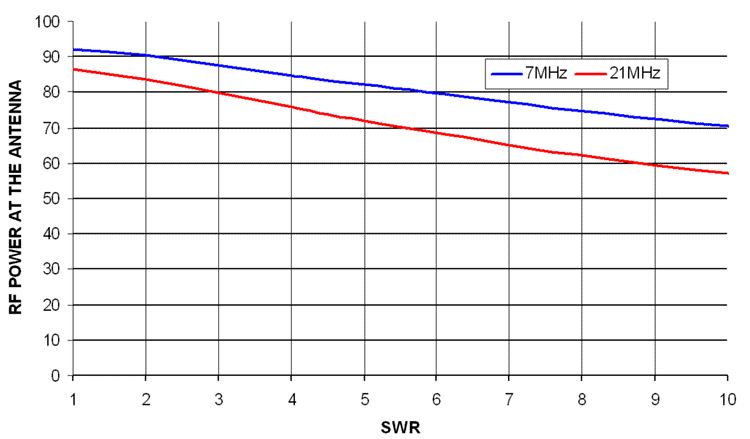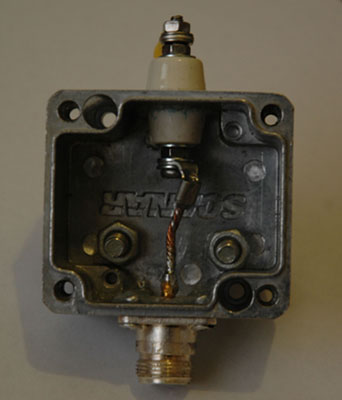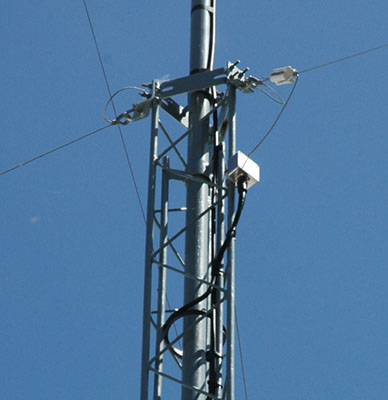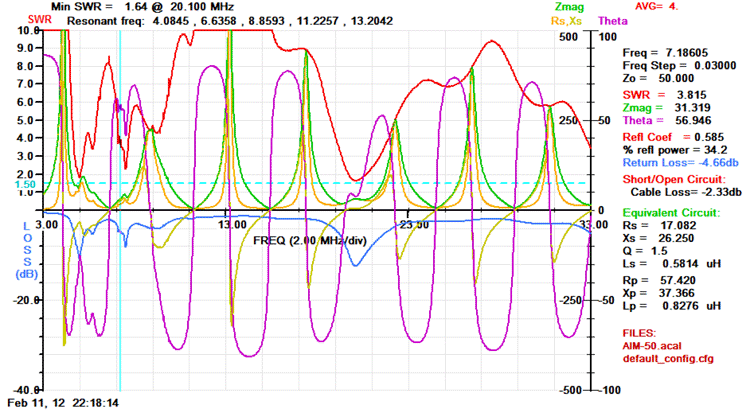|
40/15M BAND SLOPER
Guy wire sloper antenna suitable for both
40 and 15m bands. Install January 2012.
Always
attempting to get the most from any antenna and tower system I decided
that there was no reason that the tower guy wires could not be used as
additional antenna radiators. Although the guy wires are galvanized
steel, not the first choice for an antenna due to its higher material
resistance they are however a relatively heavier gauge compared to
what had been used for the multiband dipole, hopefully negating the
poorer conductivity of the steel. The antenna that most suited this
application was a 40m band sloper as the guy wire to be used was
slightly longer than a 1/4 wave length at 7 MHz and the top fed sloper
was the most convenient installation having the least impact on the
guy wire primary role; guying the tower.

Sloper
antenna for both
40 and 15m bands cut
into tower guy wire.
According
to the ARRL Antenna Book 18th Addition there are two sloper
design definitions a sloping λ/2 dipole is known among radio
amateurs as a 'full sloper' or just 'sloper.' If only one half of it
is used it becomes a 'half sloper.' The performance of the two types
of sloping antennas are similar: They exhibit some directivity in the
direction of the slope and radiate energy at low angles respective to
the horizon. The wave polarization is vertical. The amount of
directivity will range from 3 to 6 dB, depending upon the individual
installation, and will be observed in the slope direction.
The
so called half sloper antennas all have one thing in common they are
problematic when it comes to matching. There are three components that
interact to produce the feed point impedance value and therefore the
SWR result. First the length of the radiator element or wire from the
tower, secondly the angle that the radiating element has with the
tower and finally the tower and other attached hardware it's self.
The
final SWR is adjusted by altering the length of the radiating wire and
the attachment angle. The tower with its antennas and other hardware
offers less of an opportunity for adjustment with exception of an
improved earth and counterpoise system.
In
this case by using an existing guy wire there is in fact only the
radiating element length available for adjustment with the position of
the guy wire being dictated by other real world considerations. The
examples of the sloper antenna that is presented in the ARRL Antenna
Book 18th Addition and other articles show the radiating
wire angle as being 45deg however with the position of the guy wire in
this case being a predetermined 55deg this antenna will have to work
with load impedance that results.
Having
conceded that the SWR may not be ideal the aim was simple to get to as
lower value as was possible given the installation constraints and use
an ATU to correct any less than ideal SWR figure in so far as the
transceiver was concerned. At 7 MHz the relatively short 21mtr run of
RG213 should not introduce too much loss into the system. For example
if a SWR value of 3:1 at 7MHz was achieved the additional coax line
loses would be 0.28dB and
at 21MHz the additional
lose would be 0.35dB. See Fig #1 and Graph #1
|
SWR
|
7.1 MHz
@ 100W
|
21.2 MHz
@ 100W
|
|
Coax Line lose
|
Power at the antenna
|
Coax Line lose
|
Power at the antenna
|
|
1:1
|
0.357dB
|
92.116W
|
0.631dB
|
86.479W
|
|
1:5
|
0.384dB
|
91.539W
|
0.676dB
|
85.579W
|
|
2:0
|
0.438dB
|
89.081W
|
0.766dB
|
83.836W
|
|
2:5
|
0.502dB
|
89.081W
|
0.871dB
|
81.836W
|
|
3:0
|
0.571dB
|
87.689W
|
0.981dB
|
79.774W
|
|
3.5
|
0.641dB
|
86.282W
|
1.094dB
|
77.729W
|
|
4.0
|
0.712dB
|
84.885W
|
1.207dB
|
75.737W
|
|
4.5
|
0.783dB
|
83.509W
|
1.319dB
|
73.812W
|
|
5.0
|
0.853dB
|
82.161W
|
1.429dB
|
71.963W
|
Fig
#1 Comparative coax line loses for a 21 meter run of RG213 coax for 7
MHz and 21 MHz at various SWR values

Graph
#1 Comparative system output power for a 21 meter run of RG213 coax
for 7 MHz and 21 MHz at various SWR values for a transmitter input
power of 100W
The
conclusion therefore is that providing an SWR value of less than 5:1
is achieved then there is negligible losses introduce into the system.
Construction
Construction
is very simple; the existing galvanized steel guy
wire has two insulators cut into it, one at the top as near to the
tower as is possible and the other towards the ground attachment end.
The length of wire between the two insulators is about λ/4 at 7
MHz plus a bit. The insulator cut in at the ground attachment end has
wire fed through the insulator with a longish tails of about 1 meter
for easy adjustment of the final radiator length. After much
measurement and adjustment the guy wire can be more neatly terminated
in the insulator.
The
coax cable is terminated
in a weatherproof aluminium box that should be resilient to the most
hostile environments requiring little if any maintenance for the life
of the antenna.
|

|

|
|
Photo
3. Internal view of the Weatherproof coax termination box.
|
Photo
4. Weatherproof coax termination box.
The spacer block at the rear is to place the antenna connection
away from the tower.
|
|

|

|
|
Photo
5. Tower end assembly during installation
|
Photo
6. Tower end assembly fully installed
|
Measurements
The
AIM 4170C antenna analyzer produced a display that indicated the
antenna was in the ball park with two SWR dips; one just above 7 MHz
and the other at the third harmonic frequency of about 20 MHz just
below the 21m band.
The analyser
sweep of the entire HF band 3 - 30 MHz shown in graph #2 revelled an
unexpected useful dip around 5 - 6 MHz (USA/UK 60m
band)
AIM
4170C antenna analyser explanation;
|
SWR
|
Standing
Wave Ratio.
|
|
Zmag
|
Total
Impedance.
|
|
Rs
|
Resistive
component of the total impedance
|
|
Xs
|
Reactive
component of the total impedance also indicating the +/-sign of
the value. Inductive being a positive value and capacitive being
a negative number.
|
|
Theta
|
Phase
angle between voltage and current.
|
|
Return
Loss
|
Total
reflected system loss.
|
All result shown are the Sloper antenna viewed with the AIM 4170C antenna analyser as see at the
transceiver end of the coax.

Graph
#2 AIM 4170C antenna analyser of HF spectrum from
3 - 30MHz.

Graph
#3 AIM 4170C antenna analyser of HF spectrum from 6.5 - 7.5 MHz
indicates that while not suitable for directly connecting to a
transceiver with an inline ATU a usable antenna with minimal line loss
is available over the 40m band.

Graph
#4 AIM 4170C antenna analyser of HF spectrum from 20 - 22 MHz
indicates that the antenna could be directly connecting to a
transceiver, however it is intended that ATU will be used for
operations on the 15m band.
Operational
Performance
Anecdotally
the antenna seems to be performing as predicted, that is signals from
the east particularly signals from the east coast of Australia (in
relation to Western Australia) generally have marked improvement over
the multi-band dipole. There is believed to be a mild null in the
multi-band dipole on the 40m band in the easterly direction, therefore all that may be being achieved is over coming
the deficiency in
the multi-band dipole.
The
below plots for both the 40m and 15m radiation patterns were modelled
to give some clue to what was actually happening and obviously not to
be taken as gospel. The first model of the 40m pattern was a very
basic model with only the radiating element and the mast as far as the
sloper attachment point, this revealed to an almost omi-directional
pattern however when the full tower structure was included the plot
below was produced indicating some directivity. Clearly this suggests
that the tower and any attached antennas and hardware play a
significant part in the final result of the sloper antenna. Confirming
the ARRL
Antenna Book 18th Addition
description of the antenna and the crucial part that the tower and
hardware contribute to the final sloper performance.

Figure 2 Radiation pattern of
the 40-15m sloper at 7.15MHz

Figure 3 Radiation pattern of
the 40-15m sloper at 21.2MHz
Conclusion
Despite
the less than ideal galvanized steel wire for the antenna radiator,
the higher than I had hoped VSWR the antenna performed as it was
hoped. A clear 2 to 3 S point improvement in the easterly direction of
gain on the 40m band was evident when compared with the multiband
dipole. The ATU has no problem matching the antenna at both 40 and
15m. The sloper antenna also can be matched on the 80m band with
comparable performance with the multiband dipole and while it shows no
advantage it is noteworthy that it works that well.
For
very little cost there is now an additional antenna available that has
demonstrating clear advantage for certain conditions where there was
previously only a guy wire.
While
too good and convenient an antenna to be ignored, it must be recognised
that no two of these antenna are going to be alike due to the effects
of the subtitles of each individual sites and as additional antennas
are added and other removed so will the performance of the sloper
antenna.
References
ARRL
Antenna Book 18th Addition
Coax Cable and Line Loss
Calculator http://www.arrg.us/pages/Loss-Calc.htm
Loss
in antenna conductor materials
This
article explores the potential losses of popular conductor materials.
http://www.vk1od.net/antenna/conductors/loss.htm
SWR(Standing Wave Ratio) Wikipedia http://en.wikipedia.org/wiki/Standing_wave_ratio
The
above radiation plots were produced using MMANA-GAL Antenna Analyser
software by JE3HHT, Makoto (Mako) Mori at http://hamsoft.ca/
TOP
OF PAGE
Page
last revised 05 May, 2025
|